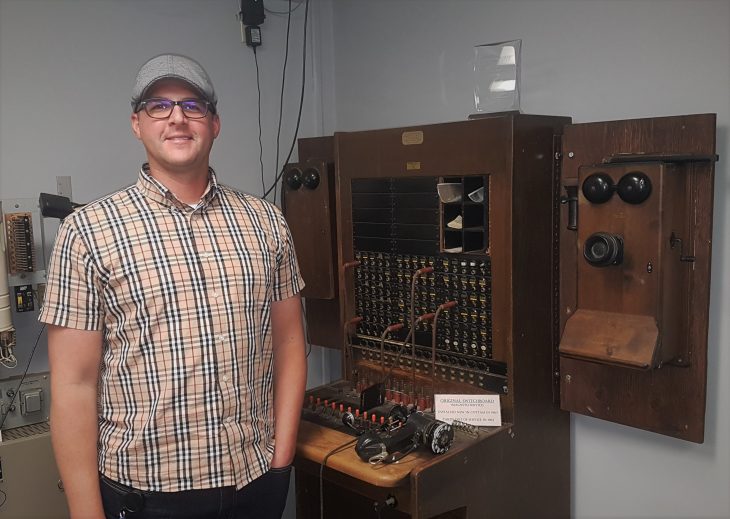
Gosfield North Communications expands rural broadband while helping migrant workers stay in touch with their families
COTTAM, Ont. – Two life altering things happened for Rob Petruk in late 2010. The first was he was hired by Gosfield North Communications as its general manager and chief technical officer.
Then an 11-year Bell Canada technology veteran who was used to dealing with a parade of brand new gizmos and cool software – and with access to huge resources – Petruk came to Gosfield North (named for the former township now part of Kingsville, Ont.) with his eyes open to the challenges of an independent telco, but also eager to dig into a small community and a network which would be his to pilot.
He grew up in Southwestern Ontario, not far from where he works now, and knew the Gosfield network’s limitations at the time. He was hired, after all, to modernize the whole thing. The board of directors “wanted a blinky light person and that was me… and I really like the idea of being able to work and function and provide service and be involved in the community you’re taking care of,” said Petruk (pictured with the company’s original Magneto switcher from the early 1900s) in a recent interview with Cartt.ca in the company’s Cottam, Ont. headquarters.
When he started there more than eight years ago, the company offered basic phone service and its Internet featured “two 45-meg internet connections to run all of the customers that we had. Our fastest internet connection was a 5 meg dial-up,” he remembered.
But in fall of 2010, as some readers will recall, that second life-altering thing happened, and not just to Petruk: Netflix launched in Canada. That immediately changed the game for anyone running a network. “Our internet took a dive,” recalls Petruk. “I remember spending two or three days during the holiday season here in the office, I think in tears, trying to figure out what we were going to do.
“We had no room left for people to access the internet because it was getting eaten up by Netflix.”
While struggling to serve customers who were all of a sudden very bandwidth-hungry, Petruk, his board, his 10 employees and local contractors quickly accelerated work to modernize the plant. “Fortunately we had some stuff already in the works to improve our situation for transport and trunking for internet access and everything like that… but I spent 2011 working with my board to come up with an action plan to bring us to where we would need to be, to be future ready,” he said.
Thankfully, some of his experience at Bell involved working with early stage technologies “that weren’t ready for consumer deployment yet,” so he had some insight into what else could be coming after Netflix and tried to harden the Gosfield network to be ready for that.
So the company underwent a full forklift upgrade, replacing “all of the equipment that we had in our central office, our core router, switches, everything like that was upgraded to a system that’s still running today that’s capable of handling even more than what we’re currently offering and expanding beyond (the) 519 (area code), if we really want to.”
Those upgrades meant fibre as deep as possible, including to the home, and by the end 2012, the launch of its own  IPTV service. “Things moved really, really quickly,” he explained.
IPTV service. “Things moved really, really quickly,” he explained.
Most of its customers inside its traditional serving area (the 839 exchange) now benefit from fibre to the home and all the speed and unlimited bandwidth that means. Soon all of its 2,200 customers in its ILEC and CLEC areas will have fibre to the home.
However, this is a growth story, too – which has meant expansion along Belle River Road through areas such as Woodslee to the community of Belle River, a picturesque community of about 5,000 on Lake St. Clair about a 30 minute drive east of Windsor. You can see the Detroit skyline from the Belle River Marina.
In fact, Gosfield has overbuilt Belle River altogether, offering free municipal Wi-Fi in partnership with the municipality of Lakeshore and competing for customers against Bell. We tested the speeds on the public, free Wi-Fi at the Marina (pictured) and found download speeds of 150 Mbps and upload speeds of 115 Mbps. Pretty good for a day at the beach or a summer on the boat.
“We took the chance knowing these people would have limited to no service and there’s a really good chance they’re going to want fibre.” – Rob Petruk, Gosfield North Communications
The fibre project from Cottam to Belle River, a 25-km stretch, has opened up a number of other attractive opportunities for the co-operative. “We started building along Belle River Road, but because of my fear of running a single line down a major road that has new houses being built, we incorporated as many of the outlying concessions, or Lakeshore roads,” said Petruk.
“By incorporating those extra outside farm roads and the farmers along them, we were able to build a rapport with the people in the community as we built through it… we took the chance knowing these people would have limited to no service and there’s a really good chance they’re going to want fibre,” while giving the new fibre network some route diversity if and when something is accidentally cut.
However, word is out among those on the Lakeshore roads where Gosfield has not run fibre – and people there want it, too. So Petruk and his team have developed a low-cost installation plan (they do underground fibre, blown into ducts) where when someone from a new neighbourhood approaches him to ask about service, Petruk anoints that person as the neighbourhood champion, asking them to see how many of their neighbours will sign up. The more neighbours, the lower the install cost. Once the numbers of new customers come back, Petruk will install the fibre at cost down that road to the homes, farms or businesses who want it.
Farmers with their own equipment are even welcome to dig their own trench and install the conduit, given to them by Petruk, if they want to take down the costs of install. Petruk declined to say exactly how low cost his plan is, but said it’s normally in the ballpark of what a year’s worth of broadband service costs per customer “with their current provider – and then usually when they convert to us, their monthly bill drops significantly.”
Plus, farmers have long needed real-time, high speed connectivity to run their businesses and keep up to the pace  of the market prices for their tomatoes, cucumbers, winter wheat or soybeans. A Gosfield fibre connection has been a godsend to those who had been relying on copper, satellite, or their cell phone. “Farmers in this area are in the middle of nowhere (and) they’re trying to compete now with the adjusted marketing and packaging laws to keep up with what’s going on in the U.S., so we have some taking gig services… to do business appropriately. Now they’re not worried about being less competitive anymore because they can get their data pushed out to the auction blocks and their (marketing group) partners and companies as fast as anyone else,” explains Petruk.
of the market prices for their tomatoes, cucumbers, winter wheat or soybeans. A Gosfield fibre connection has been a godsend to those who had been relying on copper, satellite, or their cell phone. “Farmers in this area are in the middle of nowhere (and) they’re trying to compete now with the adjusted marketing and packaging laws to keep up with what’s going on in the U.S., so we have some taking gig services… to do business appropriately. Now they’re not worried about being less competitive anymore because they can get their data pushed out to the auction blocks and their (marketing group) partners and companies as fast as anyone else,” explains Petruk.
THE NEXT OPPORTUNITY springs from serving those who work the farms. Each year thousands of labourers from places like Mexico, Jamaica and other countries arrive in Canada to do some of the difficult work needed on farms for which there aren’t enough Canadians willing. Southwestern Ontario is a large, important agricultural region and Petruk estimates there are between 5,000 to 8,000 migrant workers in the region at any given time in the planting, growing and harvesting season.
They generally arrive with their own devices to try to keep in touch with family, but find it difficult to connect with them using our large incumbent providers due to the expense, the distance away from cell towers and the fact they’re not here long enough to take advantage of any contract deals. They can generally be found in their off-hours clustered around whomever might have an open Wi-Fi hotspot.
So, Petruk has been working with farmers and extending fibre to make sure he hits the bunkhouses and despite the fact there may be a dozen or more labourers in each one, he charges a residential broadband Wi-Fi rate which they can all split, or the farmer covers the costs.
“We’ve been trying to figure out what can we do or how can we make it work to be able to accommodate someone who’s displaced 2,500 kilometers from home and just wants to talk to their family at the end of the day.” – Petruk
Even more interesting is Petruk’s early stage plan to serve many more bunkhouses – the ones too far afield for Gosfield’s fibre to reach – with fixed wireless broadband. He has partnered with the low-power independent TV station CFTV Kingsville to deploy nomadic IP technology installed on the station’s new broadcast tower in order to provide wireless broadband to bunkhouses across the region. Workers would then get a low cost subscription “to use voice services and internet services on their own without having to use free public Wi-Fi at local stores or whatever,” explained Petruk, “so they can be in the comfort of wherever they’re living and have access to the same services that we would.”
“They’re either here for six or eight or ten months so, they can’t sign up for a three-year contract to get the price that makes sense, so with CFTV, we’ve been trying to figure out what can we do or how can we make it work to be able to accommodate someone who’s displaced 2,500 kilometers from home and just wants to talk to their family at the end of the day.” CFTV’s CEO Tony Vidal has been working with the Mexican consulate to help make it happen.
Gosfield and the TV station are currently testing the fixed wireless nomadic IP service to a single bunkhouse with plans to go wide, regionally, soon after CFTV installs its new tower (watch here for a story on independent CFTV soon.)
“I think ubiquitous internet access is a great thing,” Petruk added. “They want to have internet. They want to work. They want to FaceTime with loved ones, whatever it might be. We want to make sure that we’re providing a community-oriented service that’s available for all.”




